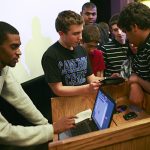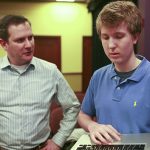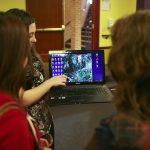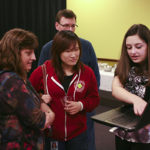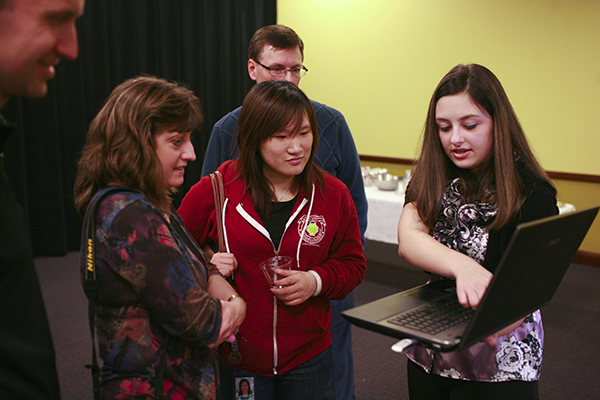
Taking computer science outside the lab
Aileen Owens, director of technology and innovation at the South Fayette Township School District, has spent the last two years bringing E-missions, robotics, video-game making, and Scratch programming classes to the district’s students in grades 4-12. Via what she calls a “real gift” from the Winchester Thurston school, Owens has also implemented an after-school iOS App Building course that gives students the chance to build applications for iPhones, iPads and other “smart” mobile devices. Existing iOS applications range from the photo-sharing app Instagram, to a New York Times reader, to games like W.E.L.D.E.R. and the collage-building tool Mixel.
Owens’ mission is for students to develop computational thinking and productive habits with technology. Exposing students to the challenges of real-world programming is a large component of her work, and she is dedicated to teaching problem-solving skills in arenas outside of the typical classroom structure.
In a summer partnership with Carnegie Mellon University, three of her students are working on a pen-based flash card application for tablet PCs that, when finished, will be beta tested in South Fayette’s third grade classrooms. One member of the group, high-school junior Benjamin Kenawell, explained that this is the first time they’ve been given a task and set off on their own to do it. His partners, senior Varun Thangauelu and junior Radhir Kothuri, nodded and elaborated that this summer they’ve had to combine their programming experience to tackle new problems “We’d never worked with databases before,” Kothuri said, “so we had to read a lot and learn how to make that work, which set us back.”
Owens’ team has faced other challenges. None of them would consider themselves designers in the formal sense of the word, so usability and attractiveness — the program’s “cool factor” — are the areas that require more attention. Owens plans to add a team of student designers to the program in the coming school year. Of course, for real-world testing, security issues also need to be considered. New scripts have been written to keep students from “cheating,” and modifications to the database (where all of the flash cards that teachers create will be stored) are still being made to keep the cards from being tampered with. These are all real world issues that the student team will have to figure out how to deal with.
Advice from CMU
To gain insight on the project, Owens’ team traveled to CMU where they met with David Kosbie and Dr. Ananda Gunawardena, associate teaching professors in the school of computer science. After reviewing their initial work, Gunawardena admitted that Owens’ students had made impressive strides, but they still had a lot of work to do until the program could be tested. It’s a long road ahead, and the project won’t be completed by their anticipated deadline, but Owens’ students are ready to address the next challenges. No matter how long their project takes, they have done exactly what Owens intended – developed the skills to think critically and solve real-world problems.
The ISO App Building program that has now grown to include multiple school districts was originally developed by three people from the Winchester Thurston School: computer science teacher David Nassar, Director of Technology John Charney, and Director of the City as Our Campus program, Teresa DeFlitch.
Two years ago, via a community partnership, programmers at Google taught Nassar how to build applications for mobile devices. Nassar then taught students in Winchester Thurston’s AP Java programming class, who in turn taught students from the South Fayette school district and Pittsburgh Obama Academy. Students from South Fayette have taught their classmates and students from the Quaker Valley School District. The program is still growing and next the Mars School District is scheduled to take part.
According to DeFlitch, Winchester Thurston is a good flagship for these kinds of educational initiatives because, “We have a research and development component. We’re trying different techniques, seeing how students react, and working on systems to help us better assess student learning and teaching. It’s a system of trial and error.”
Winchester Thurston’s experiment
This movement is part of a larger experiment at Winchester Thurston. John Charney, who has been the school’s director of technology for two and a half years, puts it this way: “The idea … is to create a mobile technology environment. We’re so connected now, compared to five years ago. It’s been a paradigm shift.” As a result, Winchester Thurston’s lower school has replaced traditional computer labs with mobile devices. “Our philosophy is that technology is another tool, like a pencil or a protractor,” Charney says. “It shouldn’t be seen as something that’s a separate class.”
Winchester Thurston also has a robotics lab where middle-school students strip sensors from devices like VCRs and connect them to a LEGO Mindstorms robot chip, which they program to do tasks in Java or C. Another class, Advanced Computer Science Innovations, is a research-based programming course that Charney describes as “almost like an independent study, but it’s a bunch of kids solving problems, working collaboratively, like in the real-world.” One year the class created an online student-scheduling manager, which the administration currently uses.
At first glance all of this might seem like a complicated curriculum to adopt. But as DeFlitch explains, you just have to take things one or two steps at a time: “We want educators to innovate, but we overwhelm them in the process, and therefore we’re holding everybody back. In order to innovate you have to put certain constraints on yourself. You have to focus and make priorities to move forward.”
There are plenty of resources available for teachers and students to expand computer science and technology learning. Robin Shoop, founder and director of CMU’s Robotics Academy believes that the best way to motivate students to pursue Computer Science, Science, Technology, Engineering and Mathematics (CS-STEM) is to support and train teachers. To that effect, the Robotics Academy trains hundreds of teachers per year and makes their training materials available for free online. Their curriculum is used by over 16,000 schools in the United States and has been translated into 13 languages.
Shoop and Carnegie Mellon have collaborated with the Defense Advanced Research Projects Agency (DARPA) to create the Computer Science Student Network (CS2N), an online center for programming lessons, contests and activities that use robotics, storytelling, game design, and animations, all available at no cost. Shoop says that they chose these activities for the program because “kids think these things are cool and because these organizers teach skill sets that are transferable across lots of industries.”
Nevertheless, attracting students has been challenging. It’s a matter of perception. Shoop chalks it up to the fact that “many kids believe that computer science is for geeks and is hard.” He maintains that the best conduit to kids is through teachers who “show kids that computing enables creativity, is critical to all future business, and most importantly is attainable.”
Ultimately, all of these efforts are about engaging kids in learning beyond the classroom. Aileen Owens concludes that a key point of her program is for her students at South Fayette “to develop leadership in the field of computer science.” As leaders, they will be prepared to solve real-world problems and take an active role in designing our future — concepts that go beyond the reach of a typical homework assignment.
Robin Shoop states it clearly: “Computer Science is the language of innovation, and robotics and web 3.0 will have the same effect on the emerging economy that the computer had on the information age. Programming and algorithmic thinking are new basics that everyone needs to know.”
Photographs courtesy Spark
